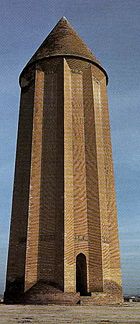Gorgan
| Gorgan | ||
|---|---|---|
| The Basij militia surveillance tower | ||
|
|
||
| Basic data | ||
| Country: |
|
|
| Province : | Golestan | |
| Coordinates : | 36 ° 50 ′ N , 54 ° 29 ′ E | |
| Height : | 148 m | |
| Surface: | 1.7 km² | |
| Residents : | 312,323 (2012) | |
| Time zone : | UTC +3: 30 | |
Gorgan ( Persian گرگان, DMG Gorgān ; Old Persian Varkâna , "land of wolves"; Arabic جرجان Dschurdschān , DMG Ǧurǧān ) is the capital of the Iranian province of Golestan and has, according to estimates in 2012 312.323 inhabitants. Gorgan is located about 30 km from the southeast coast of the Caspian Sea .
geography
Gorgan is about 400 km from Tehran . About 150 km east of Gorgan is the Golestan National Park . The city of Gorgan was the terminus of the Trans-Iranian Railway for a long time before it was extended to Turkmenistan . The city has an airport, an opera ( Talar e Fakhreddin As'ad Gorgani ), the barracks of the 30th Iranian Army and several universities.
The Rud-eh Gorgan River partially dried up and became polluted in the course of the city's growing industrialization after the Islamic Revolution .
Surname
In later times the city was called as follows: Astara , Astarwa , Satarabad , Astarbad , Astrabad or Astarabad until 1937 (= star city ; Astar , Staar , Setare means star ). The Arabic name of the city is Jorjan . Other names used in books in the past are: Waharkaneh , Warganeh , Sadrakart , Sadrakarta , Gorgin , Garjasstan , Varjan and Astareh .
There are different opinions about the origin of the name Gorgan (Persian "Wolfsland"). The area is and was heavily populated by wolves. In addition, an animal - the wolf - is said to have been trained in large numbers as an independent weapon of war here for the first time.
Gorgan should not be confused with the early medieval excavation site Gurgan (Ǧurǧān, Jurjān) near the city of Gonbad-e Qabus , also in the province of Golestan, and with the medieval ruined city of Gurganj (Urganj) further north in Turkmenistan (today Köneürgenç ).
history
In the vicinity of the city there are numerous burial mounds from pre-Islamic times. The burial mounds were used by the Turkmen to communicate over long distances during the civil war in World War I.
The city was part of the ancient Persian Empire . Historically, the area is also called Taparistan (Arabic version: Tabaristan ). The Greek name Hyrkania referred to the entire region in north-east Iran. The Caspian Sea was also called the Hyrcanic Sea by the Greeks .
This outpost was very exposed to the Turk-Mongolian raids and was destroyed many times. The Persians and Arabs living in the south also saw this rebellious and rebellious city as a breeding ground for resistance and referred to the inhabitants as "savages". The city was one of the imperial centers of the Parthian Empire . Here, for a long time, the Parish religion stubbornly held out against Islamization until the city was finally destroyed.
In addition, according to a long tradition, the highest officers of the ancient Persian emperors, the life guards , especially the immortal guards, were recruited from Gorgan . The wife of the Persian great king Dareios I also comes from Gorgan.
Towards the end of the Iran-Iraq war, the city was one of the few cities where Taalimateh Nesami (military studies) was introduced as a school subject . In addition to the Koran lessons, military studies were one of the subjects that decided on a promotion to the next class. Teachers were forced to complete a military refresher course in Gorgan at the Kuj-eh Golha rifle range .
Gorgan was actually the target of Iraqi air strikes only a few times during the Iran-Iraq war, despite frequent threats from then Iraqi ruler Saddam Hussein .
Universities
There are several universities in Gorgan:
- Gorgan University
- Islamic Asad University of Gorgan
- Golestan Medical University
 Gonbad-e Qabus, the tomb of Ziyaridenherrschers Qabus (978-1012) in Gorgan
Gonbad-e Qabus, the tomb of Ziyaridenherrschers Qabus (978-1012) in Gorgan - Gorgan Medical University
- University of Agricultural Sciences & Natural Sources
Attractions
- Nahârkhorân forest
- Alangdarreh Forest
- Tooskestan
- Golestan National Park
- Gorgan Great Wall
- Torang Tappeh in Gorgan
- Gorogh, an Armenian suburb of Gorgan with historic underground dwellings that served as hiding places from the Turks.
- Gonbad-e Qabus , a famous medieval burial tower.
sons and daughters of the town
- Fakhr-od-Dīn Ās'ād Gorgānī (unknown - probably 1054), poet (10th century), author of the epic Wīs and Ramīn
- Mohammad Reza Lotfi (1947–2014), composer and singer
- Sharif Lotfi, composer
- Isma'il ibn Hossein Gorgani, royal medic
- Ali Reza Sookhtehsaraey, world champion in wrestling
- Ayatollah Seyyed Ziaoddin Esterabadi, Islamic scholar
- Abd al-Qāhir al-Jurjānī, grammarian and book scholar
- Abu Sa'id al-Darir al-Jurjani, astronomer and mathematician
- Abu Sahl al-Masihi al-Jurjani (al-Masihi), medic and teacher from Avicenna
- Zayn al-Din al-Jurjani, royal medic
- Fazlallāh Astarābādī (1339 / 40–1394), mystic and founder of Hurufism
- Rustam Gorgani, medic
- Mir Damad, Islamic scholar and philosopher
- Mirza Mehdi Khan Astarabadi, Prime Minister in the time of Nader Shah
- Parham Maghsoodloo (* 2000), chess player
Web links
Individual evidence
- ↑ Archived copy ( Memento of the original dated December 29, 2011 in the Internet Archive ) Info: The archive link was automatically inserted and not yet checked. Please check the original and archive link according to the instructions and then remove this notice.


